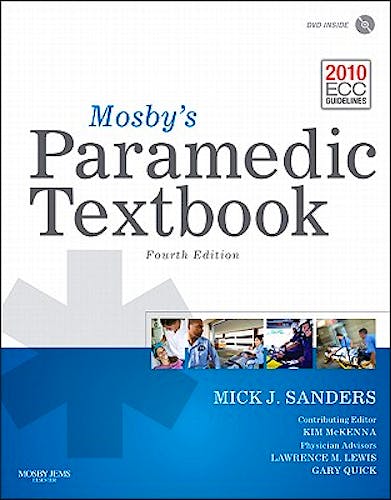

No hay productos en el carrito



Mosby's Paramedic Textbook
Sanders, M.
4ª Edición Enero 2012
Inglés
Tapa dura
1792 pags
4100 gr
null x null x null cm
ISBN 9780323072755
Editorial JONES AND BARTLETT
LIBRO IMPRESO
-5%
137,27 €130,41 €IVA incluido
131,99 €125,39 €IVA no incluido
Recíbelo en un plazo de
2 - 3 semanas
Description
Reflecting the 2010 Emergency Cardiovascular Care guidelines, Mosby's Paramedic Textbook, 4th Edition provides a comprehensive learning tool for both first-time and refresher paramedic students. Coverage includes an overview of key subjects such as pharmacology, airway management, medical disorders, patient assessment, and trauma. ALS patient care skills are presented step by step, both in the book and in online video clips. New to this edition are nine new chapters, many new topics, and 150 new photos. Written by paramedic expert Mick Sanders, Mosby's Paramedic Textbook follows the National EMS Education Standards and offers complete coverage of the National Standard Curriculum (NSC) for the EMT-Paramedic.
Key Features
- More than 1,000 illustrations -- including 150 that are NEW -- accurately present different techniques and skills.
- Chapter openers, objectives and key terms set the stage for learning.
- Advanced Life Support (ALS) skills are presented step by step and in full color.
- Critical thinking questions help in understanding concepts and in applying them to patient care.
- A summary and a list of references in each chapter make review easier.
- A herbal appendix in the pharmacology chapter provides access to herbal content.
- Drug monographs on the Evolve companion website include Mosby's Essential Drugs, with instant access to comprehensive, up-to-date information on the medications that are administered by paramedics as well as those most commonly prescribed to patients.
New to This Edition
- NEW! Nine new chapters and thoroughly updated content align the text with the new National EMS Education Standards and reflect the 2010 ECC (Emergency Cardiovascular Care) guidelines.
- NEW topics include coronary bypass, endocarditis, adult IO infusion, bird flu, new fluid resuscitation guidelines for trauma patients, drugs of abuse (Vicodin, Oxycontin), prediabetes, and management of hypothermia and drowning.
- NEW Show Me the Evidence boxes show the value and impact of evidence-based research.
- NEW Did You Know? boxes supplement chapter content with interesting and relevant information.
- NEW Look Again feature includes cross-references and specific page numbers for easy review of information that was covered in earlier chapters.
- NEW farm considerations in the Trauma section enhance rural practice with the kinematics of farm machinery incidents.
- Additional Critical Thinking boxes encourage the application of critical thinking skills to "real-life" EMS.
- Additional cultural considerations enhance your ability to deal with the issues of multicultural patients.
- NEW Advanced Practice Procedures in Critical Care appendix provides an overview of specialty procedures for paramedics who work in critical care settings.
- Revised and updated Emergency Drug Index reflects the new 2010 ECC guidelines with coverage of more than 75 emergency drugs, their dose and administration, onset and duration, indications and contraindications, adverse reactions, and special considerations.
Table of Contents
- Part One: Preparatory
- 1. EMS Systems: Roles, Responsibilities, and Professionalism
- 2. Well-Being of the Paramedic
- 3. Injury Prevention and Public Health
- 4. Documentation
- 5. EMS Communications
- 6. Medical and Legal Issues
- 7. Ethics
- 8. Research Principles and Evidence-Based Practice
- Part Two: Anatomy and Physiology
- 9. Medical Terminology
- 10. Review of Human Systems
- 11. General Principles of Pathophysiology
- 12. Life Span Development
- Part Three: Pharmacology
- 13. Principles of Pharmacology and Emergency Medications
- 14. Venous Access and Medication Administration
- Part Four: Airway
- 15. Airway Management, Respiration, and Artificial Ventilation
- Part Five: Patient Assessment
- 16. Scene Size Up
- 17. Therapeutic Communications
- 18. History Taking
- 19. Primary Assessment
- 20. Secondary Assessment and Reassessment
- 21. Clinical Decision Making
- Part Six: Cardiovascular
- 22. Cardiology
- Part Seven: Medical
- 23. Diseases of the Eyes, Ears, Nose and Throat
- 24. Respiratory
- 25. Neurology
- 26. Endocrinology
- 27. Immunology
- 28. Infectious and Communicable Disease
- 29. Abdominal and Gastrointestinal Disorders
- 30. Genitourinary and Renal Disorders
- 31. Gynecology
- 32. Hematology
- 33. Nontraumatic Musculoskeletal Disorders
- 34. Toxicology
- 35. Behavioral and Psychiatric Disorders
- Part Eight: Shock and Resuscitation
- 36. Pathophysiology and Management of Shock
- Part Nine: Trauma
- 37. Trauma Overview and Mechanism of Injury
- 38. Bleeding and Soft Tissue Trauma
- 39. Burns
- 40. Head, Face, and Neck Trauma
- 41. Spine and Nervous System Trauma
- 42. Chest Trauma
- 43. Abdominal Trauma
- 44. Orthopedic Trauma
- 45. Environmental Conditions
- Part Ten: Special Patient Populations
- 46. Obstetrics
- 47. Neonatal Care
- 48. Pediatrics
- 49. Geriatrics
- 50. Abuse and Neglect
- 51. Patients with Special Challenges
- 52. Acute Interventions for Home Care
- Part 11: EMS Operations
- 53. Ground and Air Ambulance Operations
- 54. Medical Incident Command
- 55. Rescue Awareness and Operations
- 56. Crime Scene Awareness
- 57. Hazardous Materials Awareness
- 58. Bioterrorism and Weapons of Mass Destruction
- 59. Putting it All Together: Assessment-Based Management
- Appendix: Advanced Practice Procedures in Critical Care
- Emergency Drug Index
Author Information
Mick J. Sanders, MSA, EMT-P, EMS Training Specialist, St. Charles, MO
© 2025 Axón Librería S.L.
2.149.0